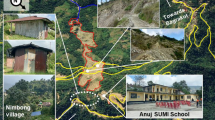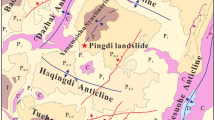Abstract
A consequent slope, comprising weak planes in the same dip direction along the slope face, is the most dangerous type of rock slope. Herein, a consequent landslide that occurred on May 5, 2018, in Mabian County, Southwest China, was investigated. This landslide occurred in a region with a complex geological background and strong geological activity and is considered a typical consequent landslide. Field investigations and aerial photographic interpretations revealed that the rock mass slipped along the contact surface of the strongly and moderately weathered rock mass, triggered by continuous rainfall. A depth-integrated continuum method was used to study the dynamic process of the landslide. The applicability of the depth-integrated method was verified by comparing the moving boundary of the landslide extracted from a video with the simulation results. The results show that the velocity of the landslide first increased and then decreased from the top to the bottom of the landslide and reached a maximum of 21 m/s in the middle of the landslide. Based on this method, we predicted the potential danger zones and velocity distribution of unstable masses next to the Mabian landslide. On comparing the calculated results of a depth-integrated continuum method with the Scheidegger method, in the case of the Mabian landslide, a reduction factor λ was added to the Scheidegger formula to achieve a modified formula that determines the velocity of such consequent landslides relatively accurately. This work could provide reference for the study of landslide velocity and disaster prevention.
























Similar content being viewed by others
References
Alan P, Edward N (2018) New simplified and improved interpretation of the Vaiont landslide mechanics. Landslides 15:2001–2015
Angeli M-G, Pasuto A, Silvano S (2000) A critical review of landslide monitoring experiences. Eng Geol 55:133–147
Cascini L, Cuomo S, Pastor M, Sorbino G, Piciullo L (2014) SPH runout modelling of channelised landslides of the flow type. Geomorphology 214(2):502–513
Castelli M, Scavia C, Bonnard C, Laloui L (2009) Mechanics and velocity of large landslides. Eng Geol 109(1–2):1–4
Chemenda AI, Bois T, Bouissou S, Tric E (2009) Numerical modelling of the gravity-induced destabilization of a slope: the example of the La Clapiere landslide, southern France. Geomorphology 109(3–4):86–93
Cina A, Marco P (2015) Performance of low-cost GNSS receiver for landslides monitoring: test and results. Geomat Nat Haz Risk 6(5–7):497–514
Crozier MJ (1999) Prediction of rainfall-triggered landslides: a test of the antecedent water status model. Earth Surf Process Landf 24(9):825–833
Clerici A, Perego S (2000) Simulation of the Parma River blockage by the Corniglio landslide (Northern Italy). Geomorphology 33(1–2):1–23
Corominas J, Moya J, Ledesma A, Lloret A, Gili JA (2005) Prediction of ground displacement and velocities from groundwater level changes at the Vallcebre landslide (Eastern Pyrenees, Spain). Landslides 2(2):83–96
Denlinger R, Iverson R (2001) Flow of variably fluidized granular masses across three-dimensional terrain 2. Numerical predictions and experimental tests. J Geophys Res 106:553–566
Denlinger R, Iverson R (2004) Granular avalanches across irregular three-dimensional terrain:1. Theory and computation. J Geophys Res 109(F1)
Evans S (2006) Single-event landslides resulting from massive rock slope failure: characterizing their frequency and impact on society. Landslides from massive rock slope failure. Springer, Dordrecht, pp 53–73
Finlay P, Mostyn G, Fell R (1999) Landslide risk assessment: prediction of travel distance. Can Geotech J 36(3):556–562
Guthrie RH, Evans SG, Catane SG, Zarco MA, Saturay RM (2009) The 17 February 2006 rock slide-debris avalanche at Guinsaugon Philippines: a synthesis. Bull Eng Geol Environ 68:201–213
Guzzetti F, Reichenbach P, Cardinali M, Galli M, Ardizzone F (2005) Probabilistic landslide hazard assessment at basin scale. Geomorphology 72(1–4):272–299
Hakan E, Murat K, Kenan G, Aykut A (2018) Modelling of the landslide-induced impulse waves in the Artvin Dam reservoir by empirical approach and 3D numerical simulation. Eng Geol 249:112–128
Huang R (2007) Large-scale landslides and their sliding mechanisms in China since the 20th century. Chin J Rock Mech Eng 26(3):433–454
Hungr O, Evans S (2004) Entrainment of debris in rock avalanches: an analysis of a long run-out mechanism. Geol Soc Am Bull 116(9–10):1240–1252
Hungr O, McDougall S (2009) Two numerical models for landslide dynamic analysis. Comput Geosci 35(5):978–992
Iverson R, Ouyang CJ (2015) Entrainment of bed material by earth-surface mass flows: review and reformulation of depth-integrated theory. Rev Geophys 53(1):27–58
Iverson R, George D (2015) Modelling landslide liquefaction, mobility bifurcation and the dynamics of the 2014 Oso disaster. Géotechnique 66:175–187
Kumsar H, Aydan Ö, Tano H, Çelik SB, Ulusay R (2015) An integrated geomechanical investigation, multi-parameter monitoring and analyses of Babadağ-Gündoğdu creep-like landslide. Rock Mech Rock Eng 49(6):2277–2299
Lied K, Bakkehoi S (1980) Empirical calculations of snow avalanche runout distance based on topographic parameters. J Glaciol 26(94):165–177
Lin SS, Lo CM, Lin YC (2017) Investigating the deformation and failure characteristics of argillite consequent slope using discrete element method and Burgers model. Environ Earth Sci 76(2):81
Lo CM, Lee CF, Chou HT, Lin ML (2014) Landslide at Su-Hua highway 115.9k triggered by typhoon Megi in Taiwan. Landslides 11(2):293–304
Lo CM, Li HH, Ke CC (2016) Kinematic model of a translational slide in the Cidu section of the Formosan freeway. Landslides 13(1):141–151
Lo CM, Lin ML, Tang CL, Hu JC (2011) A kinematic model of the Hsiaolin landslide calibrated to the morphology of the landslide deposit. Eng Geol 123(1–2):22–39
Longoni L, Papini M, Arosio D, Zanzi L, Brambilla D (2014) A new geological model for Spriana landslide. Bull Eng Geol Environ 73(4):959–970
Ma S, Xu C, Shao X, Zhang P, Liang X, Tian Y (2019) Geometric and kinematic features of a landslide in Mabian Sichuan, China, derived from UAV photography. Landslides 16(2):373–381
Ouyang CJ, He SM, Tang CA (2015) Numerical analysis of dynamics of debris flow over erodible beds in Wenchuan earthquake-induced area. Eng Geol 194:62–72
Ouyang CJ, He SM, Xu Q, Luo Y, Zhang WC (2013) A MacCormack-TVD finite difference method to simulate the mass flow in mountainous terrain with variable computational domain. Comput Geosci 52:1–10
Ouyang CJ, Zhao W, He SM, Wang DP, Zhou S, An HC, Wang ZW, Cheng DX (2017a) Numerical modeling and dynamic analysis of the 2017 Xinmo landslide in Maoxian County, China. J Mt Sci 14(9):1701–1711
Ouyang CJ, Zhou KQ, Xu Q, Yin JH, Peng DL, Wang DP, Li WL (2017b) Dynamic analysis and numerical modeling of the 2015 catastrophic landslide of the construction waste landfill at Guangming, Shenzhen, China. Landslides 14(2):705–718
Ouyang CJ, Zhao W, An HC, Zhou S, Wang DP, Xu Q, Li WL, Peng DL (2019a) Early identification and dynamic processes of ridge-top rockslides: implications from the Su Village landslide in Suichang County, Zhejiang Province, China. Landslides 16(4):799–813
Ouyang C, An HC, Zhou S, Wang ZW, Su PC, Cheng DX, She JX (2019b) Insights from the failure and dynamic characteristics of two sequential landslides at Baige village along the Jinsha River, China. Landslides 16:1397–1414
Paolo F, Giovanni B, Micol R, Jacopo A (2018) Activity and kinematic behaviour of deep-seated landslides from PS-InSAR displacement rate measurements. Landslides 15:1053–1070
Pastor M, Blanc T, Haddad B, Petrone S, Morles MS, Drempetic V, Issler D, Crosta GB, Cascini L, Sorbino G, Cuomo S (2014) Application of a SPH depth-integrated model to landslide run-out analysis. Landslides 11(5):793–812
Pastor M, Haddad B, Sorbino G, Cuomo S, Drempetic V (2009) A depth-integrated coupled SPH model for flow-like landslides and related phenomena. Int J Numer Anal Methods Geomech 33(2):143–172
Sassa K, Fukuoka H, Wang FW, Wang GH (2005) Dynamic properties of earthquake-induced large-scale rapid landslides within past landslide masses. Landslides 2(2):125–134
Savage SB, Hutter K (1989) The motion of a finite mass of granular material down a rough incline. J Fluid Mech 199:177–215
Scaringi G, Fan XM, Xu Q, Liu C, Ouyang CJ, Domenech G, Yang F, Dai LX (2018) Some considerations on the use of numerical methods to simulate past landslides and possible new failures: the case of the recent Xinmo landslide (Sichuan, China). Landslides 15(7):1359–1375
Scheidegger AE (1974) On the prediction of the reach and velocity of catastrophic landslides: 2F, 1T, 14R. ROCK MECHANICS, V5, N4, 1973, P231–236. Int J Rock Mech Min Sci Geomech Abstr 11(3):65–65
Shen W, Li TL, Li P, Guo J (2018) A modified finite difference model for the modeling of flowslides. Landslides 15(8):1577–1593
Solak KC, Tuncay E, Ulusay R (2017) An investigation on the mechanisms of instabilities and safe design of the south slope at a lignite pit (SW Turkey) based on a sensitivity approach. Bull Eng Geol Environ 76(4):1321–1341
Steffler PM, Yee-Chung J (1993) Depth averaged and moment equations for moderately shallow free surface flow. J Hydraul Res 31:5–17
Tang CL, Hu JC, Lin ML, Angelier J, Lu CY, Chan YC, Chu HY (2009) The Tsaoling landslide triggered by the Chi-Chi earthquake, Taiwan: insights from a discrete element simulation. Eng Geol 106(1):1–19
Tung SH, Weng MC, Shih MH (2013) Measuring the in situ deformation of retaining walls by the digital image correlation method. Eng Geol 166:116–126
Wang FW, Cheng QG, Highland L, Miyajima M, Wang HB, Yan CG (2009) Preliminary investigation of some large landslides triggered by the 2008 Wenchuan earthquake, Sichuan Province, China. Landslides 6(1):45–54
Wang FW, Sassa K (2010) Landslide simulation by a geotechnical model combined with a model for apparent friction change. Phys Chem Earth 35(3):149–161
Weng MC, Chen TC, Tsai SJ (2017) Modeling scale effects on consequent slope deformation by centrifuge model tests and the discrete element method. Landslides 14(3):981–993
Xing AG, Wang G, Yin YP, Jiang Y, Wang GZ, Yang SY, Dai DR, Zhu YQ, Dai JA (2014) Dynamic analysis and field investigation of a fluidized landslide in Guanling, Guizhou, China. Eng Geol 181:1–14
Zhou GD, Cui P, Chen HY, Zhu XH, Tang JB, Sun QC (2013) Experimental study on cascading landslide dam failures by upstream flows. Landslides 10(5):633–643
Acknowledgments
This research was funded by the Natural Science Foundation of China (Grant No. 41877266, 41790433), the National Key R&D Program of China (Grant No. 2017YFC1501000), the State Key Laboratory of Geohazard Prevention and Geoenvironment Protection Open Fund Research Project (Grant No. SKLGP2019K011), and the Youth Innovation Promotion Association. We wish to thank the anonymous referee for their careful reading and providing insightful comments to improve the initial version of this paper.
Author information
Authors and Affiliations
Corresponding authors
Rights and permissions
About this article
Cite this article
Wang, D., Wang, Z., Li, Y. et al. Characteristics and dynamic process analysis of the 2018 Mabian consequent landslide in Sichuan Province, China. Bull Eng Geol Environ 79, 3337–3359 (2020). https://doi.org/10.1007/s10064-020-01784-0
Received:
Accepted:
Published:
Issue Date:
DOI: https://doi.org/10.1007/s10064-020-01784-0




